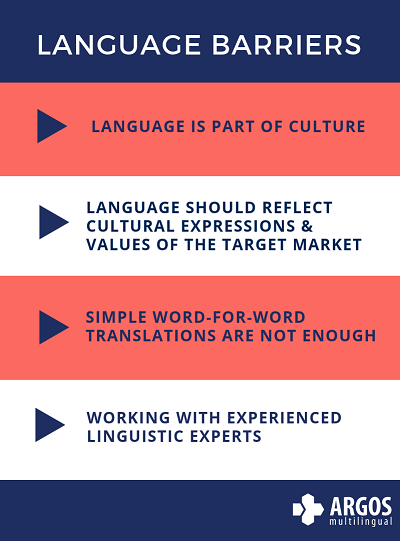How to Adapt your Marketing Content to a Global Audience
Woody Allen once said, “Eighty percent of success is showing up.” Global business leaders would agree in regards to their international business efforts. Localization professionals, however, attribute the remaining “twenty percent of success” to being prepared with quality products and communications that reflect the international markets’ culture, language, and user requirements.
Marketing professionals must localize plans and strategies for communicating with international audiences. Each target market has different values, attitudes, and buying behaviors. While the same standard product is applicable to buyers in each market, the corresponding marketing message is usually not.
In this article we show you 5 things you have to bear in mind when you are working on a global marketing strategy.
Culture in Marketing
Marketing professionals who understand the individual cultural differences and similarities realize that one universal message does not effectively reach a global audience. One global culture where people share identical values does not exist—not even within the confines of our own country. Differences in learning and thinking patterns influence the way people process information. This is reflected in their innate responses to marketing communications. Audiences differ in the way they perceive and value concepts of time, space, money, relationships, power, risk, and gender roles.
False assumptions about culture are very common—and frequently built into products and marketing strategies—as seen in the countless blunders companies have made in foreign markets. Culture continually evolves and is not limited to a country as a whole, but also to subgroups within countries.
This is a different concept than tradition, which does not change, but does influence a society’s behavior. Oftentimes, the marketing message places too much emphasis on tradition rather than culture. This can result in an unexpectedly negative impression. For instance, a savvy, high‐tech German audience instantly recognizes a man in lederhosen (a traditional German costume), but may think of it negatively since it would not support their modern and forward‐thinking cultural identity. Therefore, it is important to understand the culture of the country, including the subgroups within the country to whom you are appealing.
Incorporating Localization into Marketing Planning and Development
Historically, localization has been an afterthought in product development cycles. Today, experienced international companies, product developers, and localization managers are successfully addressing localization as a fundamental element in product planning and development processes. Marketing professionals must assume the same responsibility for addressing issues of localization. International competition makes it too easy for your audience to turn to another source that better resonates with their unique needs. Companies must actively remain sensitive to their changing markets and immediately address cultural factors.
Classification of Culture
Different cultures prefer different communication styles, thus, a message cannot be equally effective in all cultures. For some, pictures contain more information than words, and for others, the verbal message is crucial. Dr. Edward Hall, a respected anthropologist who established various intercultural behavioral schools of thought, divides cultures into high‐context and low‐context cultures. Communication in a high-context culture depends heavily on the non‐verbal aspects of communications. Low‐context cultures depend more on explicit, verbally expressed forms of communication. The United States is a low‐context culture that generally relies heavily on information communicated explicitly by words. Asian and Hispanic cultures, by contrast, resemble high‐context audiences that generally accept communications that are deeper and more complex than spoken or written messages.
The difference between high‐ and low‐context cultures helps us understand why, for example, Japanese and American advertising styles are so different. Generally, Japanese audiences prefer indirect verbal communication and symbolism over the direct “in your face” communication approaches used by Americans. To differentiate a product over the competition, American advertising traditionally relies on words to explain the advantages. In contrast, advertising communications in high‐context countries such as Japan rely on nuances and overall differences in tone, music, scenery, and other non‐verbal cues.

Language Barriers in Marketing Communications
The language a person speaks is part of their culture. Therefore, the language you use in all marketing communications, including advertising, public relations, and general communications, should reflect each target locale’s unique cultural expressions and values.
Translating marketing messages for international campaigns often leads to ineffective copy, as words expressing people’s values cannot be easily conveyed. Simple word‐for‐word conversions are not sufficient. Linguistic subtleties make copy difficult to translate without extensive creative writing and cultural analysis. A branded slogan that has conquered domestic markets rarely transliterates to another language with the same power and precision.
To ensure an effective marketing message, use experienced linguistic experts who understand how to write marketing and advertising copy in each of their languages. In trying to save on linguistic costs, companies commonly make the mistake of using in‐house bilingual resources as translators, resulting in a disparate branding message. Writing in a particular language requires the writer to think in terms of that language and the related culture.
Metaphors as Barometer of Culture
Metaphors are an interesting expression of culture. Metaphors commonly cause misunderstandings and ineffective communications in marketing. Americans have so many sports metaphors ingrained into their culture, that they often forget that many of their sports are not popular in other countries. For example, when our customers ask us for a “ballpark estimate” on a project, they are demonstrating their American cultural influences as they relate to American baseball. Avoid plays on words and colloquialisms. Keep the message simple, short, and direct.
The Importance of Cultural Adaptation in International Marketing
Communication across cultures requires a customized message. Consequently, international marketing professionals cannot use one standard for measuring effectiveness worldwide. In their efforts to chase the classic global successes of the world’s “super brands,” marketing professionals must use local branding elements that identify with the consumer’s culture. People buy what the product or service can do for them, and people want different things from the same product. In terms of marketing’s famous four Ps: Product, Price, Place, and Promotion, a marketing professional always makes adjustments in at least one of these four strategic elements, especially when attempting to address cultural differences.
Argos Multilingual’s Global Marketing Solutions
For more information on how Argos can assist you with all of your localization needs, contact us now.
Want to learn more?
 Argos Multilingual
3 min. read
Argos Multilingual
3 min. read
Technical Translations Tailored to Your Business There are many challenges manufacturing companies face when exporting their goods beyond their local territory. Regardless of whether you’re a large corporation seeking integration and harmonization across business units, or simply a small manufacturer looking for the right translation partner to support your global journey, these challenges are present. […]

 Argos Multilingual
4 min. read
Argos Multilingual
4 min. read
Linguistic assets are the foundation of your localization program. Linguistic Asset Management can seem like a daunting task. However with the right tools, processes and language service provider, you can rest assured that your assets will be fully utilized each time, and to your benefit. Linguistic assets – like Translation Memories, glossaries or style guides […]











